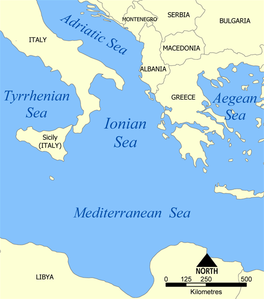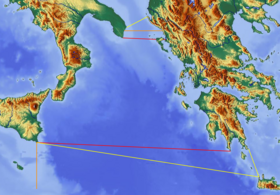Ionian Sea
| Ionian Sea | |
|---|---|
 Map of the Ionian Sea | |
| Location | Europe |
| Coordinates | 38°N 19°E / 38°N 19°E |
| Type | Sea |
| Primary outflows | Mediterranean Sea |
| Basin countries | Albania, Italy, Greece |
| Islands | List of islands in the Ionian Sea |
| Settlements | Igoumenitsa, Parga, Preveza, Astakos, Patras, Kerkyra, Lefkada, Argostoli, Zakynthos, Kyparissia, Pylos, Kalamata, Himarë, Saranda, Syracuse, Catania, Taormina, Messina, Taranto |


The Ionian Sea (Greek: Ιόνιο Πέλαγος, Greek pronunciation: [iˈonio ˈpelaɣos], Italian: Mar Ionio, Italian pronunciation: [mar ˈjɔːnjo], Albanian: Deti Jon) is an elongated embayment of the Mediterranean Sea, south of the Adriatic Sea. It is bounded by southern Italy including Calabria, Sicily, and the Salento peninsula to the west, southern Albania to the north, and the west coast of Greece.
All major islands in the sea belong to Greece. They are collectively referred to as the Ionian Islands, the major ones being Corfu, Zakynthos, Kephalonia, Ithaca, and Lefkada. There are ferry routes between Patras and Igoumenitsa, Greece, and Brindisi and Ancona, Italy, that cross the east and north of the Ionian Sea, and from Piraeus westward. Calypso Deep, the deepest point in the Mediterranean at −5,267 m (−17,280 ft), is located in the Ionian Sea, at 36°34′N 21°8′E / 36.567°N 21.133°E.[1][2] The sea is one of the most seismically active areas in the world.
Etymology

The name Ionian comes from the Greek language Ἰόνιον (πέλαγος). Its etymology is unknown.[3] Ancient Greek writers, especially Aeschylus, linked it to the myth of Io. In Ancient Greek the adjective Ionios (Ἰόνιος) was used as an epithet for the sea because Io swam across it.[4][5][6] According to the Oxford Classical Dictionary, the name may derive from Ionians who sailed to the West.[7] There were also narratives about other eponymic legendary figures;[8] according to one version, Ionius was a son of Adrias (eponymic for the Adriatic Sea); according to another, Ionius was a son of Dyrrhachus.[9] When Dyrrhachus was attacked by his own brothers, Heracles, who was passing through the area, came to his aid, but in the fight the hero killed his ally's son by mistake. The corpse was cast into the sea, which thereafter was called the Ionian Sea.[9]
Geography
Extent
The International Hydrographic Organization defines the limits of the Ionian Sea as follows:[10]
- On the North. A line running from the mouth of the Butrinto River (39°44'N) in Albania, to Cape Karagol in Corfu (39°45'N), along the North Coast of Corfu to Cape Kephali (39°45'N) and from thence to Cape Santa Maria di Leuca in Italy.
- On the East. From the mouth of the Butrinto River in Albania down the coast of the mainland to Cape Matapan.
- On the South. A line from Cape Matapan to Cape Passero, the Southern point of Sicily.
- On the West. The East coast of Sicily and the Southeast coast of Italy to Cape Santa Maria di Leuca.
Places


From south to north in the west, then north to south in the east:
- Syracuse, port, W
- Catania, port, W
- Messina, port, W
- Taranto, port N
- Himara, small port, NE
- Saranda, port and a beach, NE
- Kerkyra, port, E
- Igoumenitsa, port, E
- Parga, small port, E
- Preveza, port, E
- Astakos, port, E
- Argostoli, small port, E
- Patra, port, E
- Kyparissia, port, E
- Pylos, port, E
- Methoni, small port and a beach
- Ionian Islands
Gulfs and straits
- Strait of Messina, W
- Gulf of Catania, W
- Gulf of Taranto, NW
- Gulf of Squillace, NW
- Ambracian Gulf, E
- Gulf of Patras, connecting the Gulf of Corinth, ESE
- Gulf of Kyparissia, SE
- Messenian Gulf, SE
- Laconian Gulf, ESE
See also
References
- ^ Barale, Vittorio (2008). "The European Marginal and Enclosed Seas: An Overview". In Vittorio Barale and Martin Gade (eds) (ed.). Remote Sensing of the European Seas. Springer Science+Business Media. pp. 3–22. ISBN 978-1-4020-6771-6. LCCN 2007942178. Retrieved 28 August 2009.
{{cite book}}:|editor=has generic name (help) - ^ NCMR - MAP
- ^ Babiniotis, Lexiko tis Neoellinikis Glossas.
- ^ Jakub Pigoń (18 December 2008). The Children of Herodotus: Greek and Roman Historiography and Related Genres. Cambridge Scholars Publishing. p. 114. ISBN 978-1-4438-0251-2.
- ^ LSJ, A Greek-English Lexicon s.v. Ἰόνιος.
- ^ John Freely (30 April 2008). The Ionian Islands: Corfu, Cephalonia and Beyond. I.B.Tauris. p. 10. ISBN 978-0-85771-828-0.
- ^ John Keahey (15 July 2014). A Sweet and Glorious Land: Revisiting the Ionian Sea. St. Martin's Press. p. 116. ISBN 978-1-4668-7603-3.
- ^ Charles Anthon (1869). A Classical Dictionary Containing an Account of the Principal Proper Names Mentioned in Ancient Authors [and Intended to Elucidate All the Important Points Connected with the Geography, History, Biography, Mythology, and Fine Arts of the Greeks and Romans: Together with an Account of Coins, Weights, and Measures, with Tabular Values of the Same.]. Harper [& Brothers]. p. 679.
{{cite book}}: CS1 maint: extra punctuation (link) - ^ a b Gocha R. Tsetskhladze (2008). Greek Colonisation: An Account of Greek Colonies and Other Settlements Overseas. BRILL. p. 157. ISBN 90-04-15576-7.
- ^ "Limits of Oceans and Seas, 3rd edition" (PDF). International Hydrographic Organization. 1953. Retrieved 7 February 2010.
External links
- The Ionian-Puglia Network of Ground Meteorological Stations (Real Time Weather Observations) (in English, Italian and Greek language)
- Preveza Weather Station SV6GMQ - Live Weather Conditions (in English and Greek)
- Ionian Sea
- Seas of Italy
- Seas of Greece
- Bodies of water of Albania
- Albania–Greece border
- Marginal seas of the Mediterranean
- European seas
- Landforms of Corfu (regional unit)
- Landforms of the Ionian Islands (region)
- Landforms of Thesprotia
- Landforms of Epirus (region)
- Landforms of Preveza (regional unit)
- Landforms of Aetolia-Acarnania
- Landforms of Western Greece
- Landforms of Cephalonia
- Landforms of Achaea
- Landforms of Messenia
- Landforms of Peloponnese (region)
